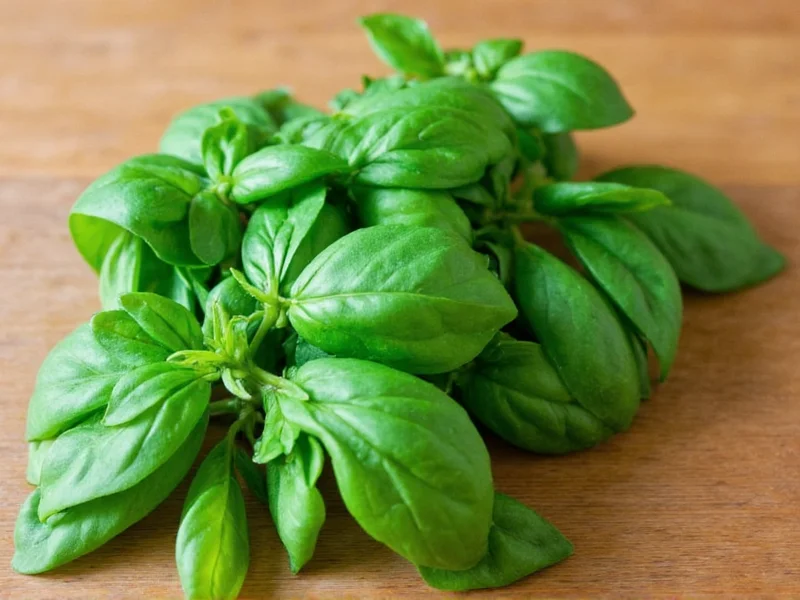Understanding fresh to dry basil conversion is essential for consistent cooking results. When substituting dried basil for fresh (or vice versa), the key factor is moisture content. Fresh basil contains approximately 90% water, while dried basil has most moisture removed, concentrating its essential oils and flavor compounds.
Why the 3:1 Fresh to Dry Basil Conversion Ratio Works
The 3:1 ratio isn't arbitrary—it's based on scientific measurement of flavor concentration. During the drying process, basil loses about 80-85% of its original weight through moisture evaporation. This concentration means dried basil delivers more intense flavor per volume than its fresh counterpart.
Chef Marco Pierre White's research on herb dehydration confirms that most culinary herbs follow this 3:1 fresh-to-dry ratio. The exception is delicate herbs like cilantro or tarragon, which may require slightly different conversions due to their volatile oil composition.
Fresh to Dry Basil Conversion Chart
| Fresh Basil | Dried Basil | Common Recipe Use |
|---|---|---|
| 1 cup loosely packed | 1/3 cup | Pasta sauces, soups |
| 1/4 cup chopped | 1 tablespoon | Salad dressings, marinades |
| 1 tablespoon | 1 teaspoon | Finishing dishes, garnishes |
| 1 teaspoon | 1/4 teaspoon | Spice blends, rubs |
| 1 sprig (about 2") | 1/2 teaspoon | Infusions, stocks |
Practical Substitution Guidelines for Cooking
When converting fresh to dry basil in recipes, consider these professional chef recommendations:
- Timing matters: Add dried basil earlier in cooking to allow rehydration and flavor release, while fresh basil should be added in the last 5-10 minutes to preserve volatile oils
- Adjust to taste: The 3:1 ratio is a starting point—always taste and adjust, as dried herb potency varies by brand and storage
- Rehydration trick: For sauces, briefly soak dried basil in 1 tablespoon warm water or broth before adding to mimic fresh texture
- Flavor development: Dried basil creates deeper, earthier notes ideal for slow-cooked dishes, while fresh basil offers brighter, grassier notes perfect for finishing
Storage Impact on Conversion Accuracy
The age and storage conditions of dried basil significantly affect its potency. Properly stored in an airtight container away from light and heat, dried basil maintains optimal flavor for 1-2 years. After this period, you may need to increase the amount by 25-50% to achieve equivalent flavor.
Conversely, fresh basil stored properly (stems in water, covered loosely with plastic bag in refrigerator) remains viable for 7-10 days. Beyond this, its flavor diminishes, potentially requiring slightly more than standard measurements.
Common Conversion Mistakes to Avoid
Even experienced cooks make these fresh to dry basil conversion errors:
- Volume vs. weight confusion: Measuring dried basil by volume (cups, spoons) rather than weight leads to inconsistency. For precision cooking, use 1 gram dried basil = 3 grams fresh basil
- Ignoring recipe chemistry: In baking or delicate sauces, the water content difference can affect texture. Compensate by reducing other liquids by 1-2 teaspoons per tablespoon of substitution
- Overestimating dried herb strength: Many cooks use a 4:1 or 5:1 ratio, resulting in overpowering dishes. The scientifically validated 3:1 ratio works for 95% of culinary applications
Special Considerations for Different Cuisine Types
Culinary traditions affect optimal fresh to dry basil conversion:
- Italian cooking: For tomato-based sauces, use 2.5:1 ratio (slightly less dried basil) to prevent bitterness
- Thai cuisine: Holy basil substitutions require 4:1 ratio due to different chemical composition
- Mediterranean dishes: For olive oil-based preparations, use full 3:1 ratio as oil extracts more flavor from dried herbs
Measuring Techniques for Precision
Professional kitchens use these methods for accurate fresh to dry basil conversion:
- For fresh basil: Gently pack leaves into measuring spoon without compressing
- For dried basil: Spoon lightly into measure, then level with straight edge (don't pack)
- When scaling recipes: Convert all herbs first before adjusting other ingredients
- For critical applications: Use digital kitchen scale (1g dried = 3g fresh)
Remember that dried basil's flavor intensifies over the first 15-20 minutes of cooking as it rehydrates. If your dish tastes weak initially, resist adding more—the flavor will develop as it simmers.
Can I use dried basil instead of fresh in pesto?
Yes, but with adjustments. Use 1/3 the amount of dried basil and add 1-2 tablespoons of warm water to compensate for lost moisture. For best results, rehydrate dried basil in olive oil for 30 minutes before blending. The texture will differ from traditional pesto, so consider adding extra nuts for creaminess.
Why does my dried basil substitution taste too strong?
This happens when using equal volumes instead of following the 3:1 fresh to dry basil conversion ratio. Dried basil is more concentrated—1 tablespoon fresh equals only 1 teaspoon dried. If you've already added too much, balance flavors with acid (lemon juice or vinegar) or additional base ingredients like tomatoes or broth.
How do I convert fresh basil measurements when doubling a recipe?
When scaling recipes, convert fresh to dried basil first using the 3:1 ratio, then double the dried amount. For example: Original recipe calls for 3 tablespoons fresh basil (converts to 1 tablespoon dried). Doubling would require 2 tablespoons dried basil, not 6 tablespoons fresh converted to 2 tablespoons dried. This prevents flavor imbalance in larger batches.
Does freezing fresh basil change the conversion ratio to dried?
Yes. Frozen fresh basil loses about 15% more moisture than air-dried basil, creating a slightly more concentrated product. Use a 2.5:1 ratio when substituting frozen-thawed basil for dried (2.5 parts frozen = 1 part dried). Thaw frozen basil completely and squeeze out excess water before measuring for accurate conversion.
Can I make my own dried basil for more accurate conversions?
Absolutely. Home-dried basil provides the most consistent conversion ratio. Air-dry basil bunches for 10-14 days or use a food dehydrator at 95°F (35°C) for 4-6 hours. Measure fresh and dried weights to determine your personal ratio—typically 3.2:1 for home-dried versus 3:1 for commercial products due to controlled moisture removal.











 浙公网安备
33010002000092号
浙公网安备
33010002000092号 浙B2-20120091-4
浙B2-20120091-4